In each issue of SO Vermont Arts & Living, we cover gallery openings, festivals, people, entrepreneurs — all the things that encompass the Southern Vermont lifestyle. The timeline is a just a tip of the iceberg that we enjoyed sharing with you as we travelled down memory lane in flipping through back issues of the magazine. There was so much more we could have included! We hope these vignettes of material from this time shows the enduring drive of our artists to create and be creative — and the perpetual challenge of keeping a vibrant, local economy where plenty of people come to visit, where Vermonters thrive, and where artists make us look at and think about our world just a little bit differently. Enjoy!
— Compiled by Jeff Potter and condensed from the words of the original writers
To explore all of these past issues (except 2008), please use the the Past Issues menu tab at the top of this page.
2008
In 2008, work proceeded apace on the $300,000 renovation of the Harris Hill Ski Jump in Brattleboro. The jump, built by Fred Harris in 1922 for $2,000 with help from local ski enthusiasts, was completely redesigned and rebuilt with a new takeoff, re-graded landing, and new spectator steps, making it the newest and most modern of its size in the country. Over the years, Harris Hill has been the site of 18 national and regional championships, and in 1992 it hosted the National Championships.
In 2018, jumpers will once again compete in this local sports institution. See pages 26–27.
In December 2008, on the eve of the 70th anniversary of the opening of the Latchis Theatre, the Brattleboro Arts Initiative (which in 2011 would rebrand itself as LatchisArts) announced its largest pledge to date for a second phase of fundraising to take the theater and hotel, an anchor of downtown Brattleboro, to the next level and more fully realize the project’s goals. The Thomas Thompson Trust awarded a $150,000 challenge grant for the subsequent phase of the massive rehabilitation project.
See pages 42-45 for an update on the building and its role in the arts community of Southern Vermont.
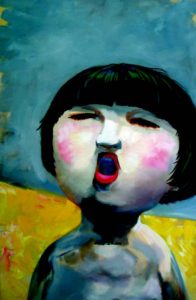 “One’s conception of oneself and others maintains the highest emotional and intellectual impact of any other phenomenon,” wrote Clara Rose Thornton, reviewing the Brattleboro Museum and Art Center’s exhibit “As Others See Us: The Contemporary Portrait.”
“One’s conception of oneself and others maintains the highest emotional and intellectual impact of any other phenomenon,” wrote Clara Rose Thornton, reviewing the Brattleboro Museum and Art Center’s exhibit “As Others See Us: The Contemporary Portrait.”
Showcasing more than 80 artists working in far-reaching mediums, “there is much fodder for introspection, analysis and revelation,” Thornton wrote.
“Forget about the fact that it’s artwork, but rather just these faces, these other human faces looking back at you,” BMAC Executive Director Danny Lichtenfeld told SO Vermont Arts & Living. “What I like most about this exhibit is that it not only represents our community in visual terms; it also requires community members to come together in shared physical space to view and reflect on who we are, and who our neighbors are.”
Ten years later, Lichtenfeld remains the leader of the museum, which is in the beginning stages of some expansion plans.
In our inaugural issue, Publisher and Editor Lynn Barrett wrote: “Yes, life is still special here. We hope our cultural and village hopping tours will inspire folks to get out there and take an inspirational journey.” This issue, Anita Rafael, who wrote the original tour story, retraces her steps a decade later starting on page 52.
2009
The Bennington Museum presented the first major retrospective of David Gil’s work, showing the variety of ceramic products designed by Gil and produced by Bennington Potters over 50 years. Bennington was once a prosperous ceramics center prior to the 20th century, and Gil’s design concepts and business management carried forward both traditions and innovation.
Gil’s widow, Sheela Harden, assumed the role of president and CEO of Bennington Potters after her husband’s death in 2002 — a position that she still holds in 2018.
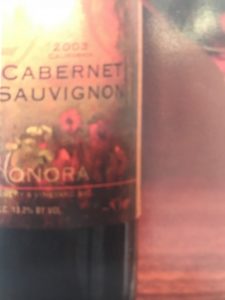 In writing about the budding industry of vinting in New England, Clara Rose Thornton observed, “The majority of Vermont’s vineyards are in a youthful phase, as it takes several years to establish grape vines, and boutique wineries dominate the industry. There are also larger wineries that in the past outsourced grapes from California and are now integrating their own vines into their inventory.”
In writing about the budding industry of vinting in New England, Clara Rose Thornton observed, “The majority of Vermont’s vineyards are in a youthful phase, as it takes several years to establish grape vines, and boutique wineries dominate the industry. There are also larger wineries that in the past outsourced grapes from California and are now integrating their own vines into their inventory.”
Thornton called Honora Winery and Vineyard in West Halifax, founded in 1994, as an example. Its first wines made from grapes grown in Vermont became available in 2008. In 2018, Honora offers seven varieties of award-winning wines, and its principals also operate J’Ville Craft Brewery, which similarly uses hops grown on the same land as the grapes.
Lyman Orton, a member of the family dynasty that owns the Vermont Country Store, combined three of his greatest passions — art, planning, and Vermont — into one large project, “The Art of Action: Shaping Vermont’s Future through Art.”
In 2009 Orton bankrolled 10 visual artists an average of $25,000 each to create works of art based on their visions of Vermont’s possible future.
The final exhibition, which made its way across the state in a 10-month tour, included the works of three artists from Southern Vermont: Charlie Hunter of Bellows Falls, Dana Wigdor of Brattleboro, and David Brewster of Halifax.
A consortium of arts groups began working with the New England Youth Theatre to create an “arts campus” at the Brattleboro nonprofit’s campus, which opened in 2007. That was not to be; Fulcrum Arts, New England Center for Circus Arts, and Brattleboro Music Center all have since built their own respective facilities elsewhere — and separately — in Brattleboro.
2010
West Brattleboro violin maker Doug Cox — then-coordinator of the nascent Brattleboro-West Arts collaborative — coined the term “articulture” to describe part of the group’s identity and purpose.
“Art is part of the working landscape,” Cox wrote. “As we take deep satisfaction from the patterns we see when the world is shaped by the practices of good agriculture, so our lives and communities are enriched when shaped by the practices of good art.”
In 2018, Brattleboro-West Arts continues to be an active force in the lives of area artists. Walter Slowinski, a maker of wood-fired pottery, now coordinates the group.
Nothing good can come of discovering your beautiful old post-and-beam barn has been chewed up by carpenter ants — or can it? In our Summer 2010 issue, Joseph Cincotta and Julie Lineberger of Wilmington of LineSync described how having to build anew turned their workplace into a “laboratory.”
“When we built it, we experimented with the elements and systems we use in our other projects,” Cincotta said,
Each choice of material or design element had to carry significant extras — energy efficiency, long-term cost savings, and the like.
LineSync is still in that studio going strong, and Lineberger also runs a new business there — WheelPad L3C — that creates eco-friendly, temporary additions that can make one’s home accessible.
“Vermont has long been a magnet for the talented and creative people seeking the quiet and contemplative lifestyle that would be conducive to their work,” wrote Arlene Distler in our Summer 2010 issue, where she described the State of Craft exhibit. In 25 showcase events across the state and a major exhibition at the Bennington Museum, State of Craft sought to document, preserve, and interpret the history of theVermont studio craft art movement from 1960 to 2010.
In the following issue, Distler interviewed participating artists from Southern Vermont, including William LeQuier of Readsboro, whose glasswork is pictured here.
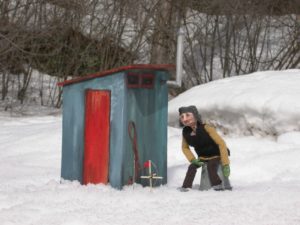 In 10 years publishing this magazine, we’ve covered nearly every type of arts festival in existence, including the internationally acclaimed Puppets in the Green Mountains, held alternating years in Putney and spearheaded by Sandglass Theatre.
In 10 years publishing this magazine, we’ve covered nearly every type of arts festival in existence, including the internationally acclaimed Puppets in the Green Mountains, held alternating years in Putney and spearheaded by Sandglass Theatre.
2011
In a profile of the poet, Joyce Marcel asks: “Who else but poet Verandah Porche (pictured) could — or would — write a poem called ‘For Our Road Commissioner on Retirement’ and nail that small and precious piece of rural Vermont winter life with such a laser beam of accuracy?”
Porche, for her part, said she “wanted [her] life to be a poem.” And she helps others in places like schools, nursing homes, factories, and senior centers see the poetry in their lives by eliciting “rich and passionate text, editing out [her] voice, and distilling together — with the narrator — a beautiful piece of work.”
In the 1960s, Porche moved with a number of countercultural artists and writers to an old farm in Guilford; the group named it Total Loss Farm. She has lived there since. “The people who stuck around here had one foot in the world of being freaks, and we all did our best to become pillars of our communities in our own ways,” she observed.
Prescient words — in 2016, Porche was elected to the Guilford Selectboard.
With Vermont’s economy slowly rebuilding during the Great Recession, Governor Peter Shumlin, pictured, expressed his desire to be the “first arts governor” since Madeline Kunin. In an editorial, Lynn Barrett quoted Alex Aldrich about the economic returns on government investment in promoting the arts.
The Vermont Arts Council executive director’s take: “The healthier and more vibrant the arts in a community, the better the cultural and educational opportunities will be.”
“Let’s trust that Governor Shumlin is serious about becoming the ‘arts governor’ of Vermont. It could be just what the doctor ordered,” Barrett concluded.
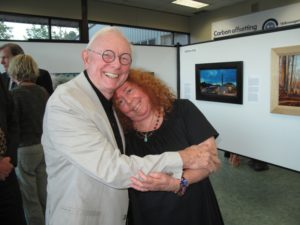 “Folk art is simplified,” the ebullient contemporary folk artist Warren Kimble told Joyce Marcel; both are pictured here. “People understand it. They can see something they recognize. In my case, what I’ve found through the years is that people of all walks of life, sophisticated, unsophisticated, see something in it and get something from it. It crosses gender lines.”
“Folk art is simplified,” the ebullient contemporary folk artist Warren Kimble told Joyce Marcel; both are pictured here. “People understand it. They can see something they recognize. In my case, what I’ve found through the years is that people of all walks of life, sophisticated, unsophisticated, see something in it and get something from it. It crosses gender lines.”
The internationally famous Kimble, a former art teacher and antiques dealer, lives in Brandon, where his success has helped establish the town as a vibrant arts community.
“Art is the total of one’s experiences,” Kimble said. “And if you don’t have experiences, I don’t know how you create.”
2012
Resilience: “That certainly seems to describe Vermont and Vermonters in the aftermath of Tropical Storm Irene,” wrote Publisher/Editor Lynn Barrett in the Winter 2011–2012 issue, the first since the region was battered the previous fall.
Elsewhere in the issue, Steve Noble profiled pastel artist Ann Coleman (pictured), of Wilmington, whose gallery — under loving renovation and slated to open within weeks — was swept away in minutes.
In the Summer 2012 issue, Dan DeWalt, an artisanal woodworker, and a member of the Rock River Artists group, recalled the flood and its effects on the West River Valley. Among the members is Georgie, a painter, shown here next to the chewed-up landscape in the days after the flood.
 “We found ourselves separated from our landscape and awash in uncertainty,” he wrote.
“We found ourselves separated from our landscape and awash in uncertainty,” he wrote.
“When the skies cleared, the entire community worked to recover what was salvageable, clear way what wasn’t, and provide solace and assistance to those who experienced loss,” DeWalt observed. “What we discovered was how little we really knew about each other.”
“The river that connected us tore us apart,” artist Deirdre Scherer told DeWalt. “But in the end, the catastrophe did the opposite and connected us more closely after all.”
The Great Hall of Springfield, Vt. opened in the once-productive and historic Fellows Gear Shaper building, now known as One Hundred River Street. The factory was one of the largest and best known of the precision tool industry buildings in that town. Now, after a multi-million-dollar renovation the building includes a medical center, and space for retail, restaurants, and the new venue for public art — the Great Hall. With soaring 25-ft. ceilings and atrium windows, the hanging space for art and space for sculpture is dramatic.
Next Stage Arts, a nonprofit group formed in 2009 to look into converting a former church in Putney into a performing arts center, started life as a frugal volunteer effort. But in 2012, the group began the process of raising $1.3 million to make the building accessible, an effort that was ultimately successful.
Revitalization was a central goal when Next Stage formed, according to Eric Bass of Sandglass Theater, one of the artists who spearheaded the effort. But another goal, Bass told writer Katherine Cox, was to help grow the town’s cultural identity, to make the town a cultural destination and to collaborate with other civic and cultural organizations, like Yellow Barn Music and Twilight Music.
2013
Four artists, all from Southern Vermont, received the 2012 Governor’s Award for Excellence in the Arts from the Vermont Arts Council. We were able to ask three of the four what they would say about the relationship of place to creativity.
“In Vermont, the inclination toward the common good has provided the fertile soil in which I have grown as a person and as an artist,” said Karen Hesse, a novelist.
Sharon Robinson, a cellist and teacher, said, “Living in Vermont, with its natural beauty, has given my music-making an expansiveness. The slower pace here seeps into everything I do and lets me be more patient with my musical quests.”
And for Archer Mayor, author of the acclaimed Joe Gunther mystery novels, “It is crucial to what I do, giving my entire body of work a geographical and cultural base, but it also feeds my inner artist […] by supplying the sort of supportive and nurturing environment that I was searching for when I first came here 33 years ago.”
The fourth, Stephen Stearns, a teacher, director, professional clown, mime, and actor, cofounded New England Youth Theatre. (At right: Mayor and Stearns at the awards ceremony.)
Brattleboro Museum & Art Center mounted a significant show of the work of Red Grooms, a major figure in American art. “Red Grooms: What’s the Ruckus?” focused on three veins of his work: the circus, New York City, and art about art. Grooms’ daughter, Saskia Grooms, who lives in Southern Vermont, advocated for getting a showing of her father’s work into BMAC.
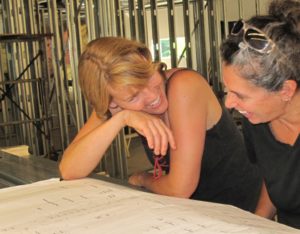 Randi Solin and Natalie Blake — entrepreneurial artists who work in glass and clay, respectively — created Fulcrum Arts Center, a half-million-dollar project to purchase the former Tom and Sally’s building on Route 30 for a studio, gallery, retail, and educational space. They purchased the property after seven years and thwarted attempts at purchasing at three other sites in Brattleboro. They recently rebranded the business as Fire Arts Contemporary Craft Gallery and Open Studio.
Randi Solin and Natalie Blake — entrepreneurial artists who work in glass and clay, respectively — created Fulcrum Arts Center, a half-million-dollar project to purchase the former Tom and Sally’s building on Route 30 for a studio, gallery, retail, and educational space. They purchased the property after seven years and thwarted attempts at purchasing at three other sites in Brattleboro. They recently rebranded the business as Fire Arts Contemporary Craft Gallery and Open Studio.
In 2013, we first noticed how the internet lodging service Airbnb was deregulating the traditional B&B experience. While local renters reported benefits — liking the experience and the extra income — state Commissioner of Tourism and Marketing Megan Smith said the service was likely taking business from local Bed & Breakfasts, and she wasn’t about to promote the site’s use.
“We’ll have to wait and see how it plays out,” she says. “Unfortunately, it’s not something we have any control over right now.”
2014
The first sell-out event of The Hatch, “Take a Seat: Storytellers on a Mission,” raised $27,000 for the Latchis, then raising money to restore the ceiling and seats in the theater. The inaugural event kicked off at the Latchis with five top storytellers: PJ O’Rourke, Adam Wade, Jim O’Grady, Peter Aguerro, Ed Gavagan and host Brooke Van Poppelen.
The art of storytelling is “addictive on both ends, the audience and the storyteller,’ said Tom Bodett, a Dummerston resident and one of the founders of the group (shown here on stage with a student from New England Youth Theatre) formed to bring national talent to the local stage to benefit nonprofits in the area.
The group subsequently staged shows to benefit Youth Services, NEYT, Morningside Shelter, Vermont Parks Forever, and the Winston Prouty Center.
Six colleges in southeastern Vermont formed a partnership to allow students at any of the schools to take classes at the others. The two statewide colleges — Community College of Vermont and Vermont Technical College — joined Marlboro College, Union Institute, Landmark College, and the School for International Training to create the Windham Higher Education Cooperative.
CCV and VTC opened a shared campus in the Brooks House in downtown Brattleboro following the building’s restoration after a devastating fire in 2011.
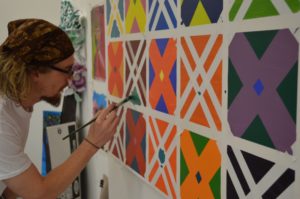 From the opening of Landmark College’s Fine Arts Gallery to the student art displayed front and center there, the school began using the new facility as a “fundamental element of education and life,” said Humberto Ramirez, professor of art at the private college for students who learn differently.
From the opening of Landmark College’s Fine Arts Gallery to the student art displayed front and center there, the school began using the new facility as a “fundamental element of education and life,” said Humberto Ramirez, professor of art at the private college for students who learn differently.
After renovations that included rebuilding one wall, finishing others and installing art-friendly lighting, the gallery opened in 2013 and has featured student work, faculty work and faculty-curated exhibits by professional artists. Soon after its opening, a multimedia show showcasing the work of eight emerging New England women artists caught the attention of the art world beyond the gates of picturesque Putney campus.
“It made out of a little place, a big place culturally,” said Ramirez.
2015
It’s no secret that Vermont is a beer mecca, but while the Vermont beer juggernaut chugs along, one can’t help but notice just how concentrated the recent buzz is to the northern half of the state.
But while some Southern Vermont brewers admit it can get a little lonely down here, they also report a decorated history, a competitive advantage, and plenty of room to grow here, wrote Troy Shaheen, who profiled stalwarts like MacNeill’s and upstarts like Hermit Thrush, whose co-owner, Christopher Gagné, is pictured here with the company’s canning equipment.
Restoration of the iconic 1871 Brooks House, an iconic building spanning half a block in downtown Brattleboro, has brought grandeur back after a five-alarm fire swept through in 2011.
The renovated building is a stylish mix of historical detail fused with contemporary design whose underlying purpose was “to help revitalize Brattleboro and create energy. To make Brattleboro better than it was before. To activate Main Street. To get more people downtown and help the town as a whole,” said architect Bob Stevens, who, with partners Craig Miskovich, Ben Taggard, Drew Richards, and Pete Richards, stepped in to save the local landmark.
“We didn’t replicate all of the original architectural features that had been removed over the years. We did restore everything that was remaining at the time of the fire and replicated the historic storefronts. What we rebuilt, we rebuilt right,” outside and in, Stevens said.
The final cost was approximately $24 million, including $1.5 million just to stabilize the building after the fire.
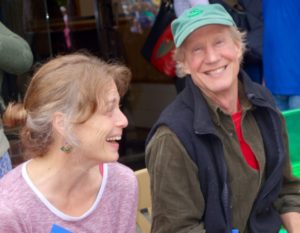 Mitchell-Giddings Fine Art is a sleek and airy gallery in Brattleboro, designed with plenty of wall and floor space to show the kind of large-scale work favored by so many contemporary artists.
Mitchell-Giddings Fine Art is a sleek and airy gallery in Brattleboro, designed with plenty of wall and floor space to show the kind of large-scale work favored by so many contemporary artists.
Owners Petria Mitchell and Jim Giddings, both painters, were founding members of the Windham Art Gallery, which closed in 2009. For many years, both did work for the Brattleboro Museum and Art Center — Giddings on installations and lighting, and Mitchell chairing exhibitions and curating.
In the Fall 2015 issue, Arlene Distler reported of the duo’s hopes to represent 25 artists, both locally and from afar. Such diversity “will keep our gallery exciting, current, and create more opportunities for artists while also offering our collectors the opportunity to expand their collections and their point of view,” said Mitchell. The goal: “diversity in style and media within a contemporary aesthetic that has not been available in our area previously.”
2016
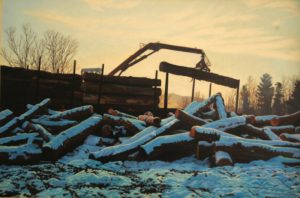 “‘Shedding Light on the Working Forest,’ an exhibition of paintings and poems at Brattleboro Museum and Art Center, is the deepest expression of an artistic friendship, nurtured over 25 years,” wrote poet Verandah Porche, who collaborated with artist Kathleen Kolb on the project and described it in our Winter/Spring 2015–2016 issue.
“‘Shedding Light on the Working Forest,’ an exhibition of paintings and poems at Brattleboro Museum and Art Center, is the deepest expression of an artistic friendship, nurtured over 25 years,” wrote poet Verandah Porche, who collaborated with artist Kathleen Kolb on the project and described it in our Winter/Spring 2015–2016 issue.
The show married poetry with the painted image in a celebration of the life and lore of the Vermont forest.
“When Kathleen presented this series of paintings, I was struck by their humanity,” Porche wrote. “Though utterly dependent on forest products, the public tends toward sentimentality about trees and ambivalence about loggers. Their essential work is hiding in plain sight.”
At the Bennington Museum, “Digital 3D: Here and Now” celebrated what the museum described as the “reciprocal influence of artists, designers, and manufacturers” that has made the town a nexus of technology and creativity.
The show presented an array of objects, from airplane parts to sculpture, all with one common quality: a connection to Bennington.
But while the show has a strong local bias, it also has a broad reach. Many of the items manufactured in Bennington are used around the world. The multidisciplinary artists in the show showed influence from far beyond Southern Vermont.
The show “brings to light the role of the makers and the technology they use who are putting Bennington on the map by expanding the possibilities of 3D design technology on a global stage,” explained the museum’s marketing director, Susan Strano.
The green economy cluster has been going full throttle in Southern Vermont, and it now encompasses more than 120 businesses, colleges, and organizations, three states, and four counties: Windham and Bennington counties in Southern Vermont, Cheshire County in New Hampshire, and Franklin County in Massachusetts.
Anchored by Alex Wilson, whose Environmental Building News was founded in Brattleboro in 1992, entrepreneurs, high-tech data scientists, architects, engineers, loggers and foresters, town and city planners, farmers, and even bankers have been developing innovative organizations, products and services that is not only meeting the rapidly accelerating challenge of climate change but exploring some of its opportunities.
2017
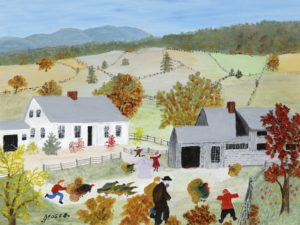 Bennington Museum — home to the largest public collection of works by Anna Mary Robertson Moses, presented “Grandma Moses: American Modern,” the largest show of the beloved folk artist’s works assembled in decades.
Bennington Museum — home to the largest public collection of works by Anna Mary Robertson Moses, presented “Grandma Moses: American Modern,” the largest show of the beloved folk artist’s works assembled in decades.
Some 60 of her works were displayed near works by such Modernists as Fernand Léger, Joseph Cornell, Helen Frankenthaler, and Andy Warhol, and folk artists such as Edward Hicks and Joseph Pickett.
“It will upset your expectations and get you to look at this beloved American artist with fresh eyes,” our Calendar item read. “It is a long-overdue exhibition that will reestablish her place in the mid-century art world that was embracing modern art at the same time.”
Occasionally overlooked as part of Vermont’s history are the African Americans who made their home here. Now, the African American Heritage Trail encourages black travelers to visit the state by offering journeys to exhibits and cultural sites that explore their stories and those of some of their fellow Vermonters.
One of the stops: Grafton, where visitors can learn about former slaves Alec and Sally Turner, and their daughter, Daisy, pictured here, at the Grafton History Museum, walk the streets of the village, and visit the church where the family worshiped.
Rudyard Kipling, the British Nobel-prize-winning author, penned some of his most famous works in his beloved Dummerston home, which he named Naulakha, Hindi for “priceless jewel.”
The desk where he wrote is still there. You can also sleep in his bed, cook in the kitchen, dine at his table, and play billiards in his game room. It’s all still there, just as it was when he lived there in 1892.
Landmark Trust USA, based down the road, celebrated its 25th anniversary of purchasing the property, which had been abandoned for 50 years.
“The life of a self-employed artist in Vermont has its ups and downs,” wrote local thespian, author, and educator Peter Gould in our Talk of the Arts column, where he advocated something he called “the Slow School Movement.”
“We’re asking to start a Slow School Movement right here in Vermont, with teachers and schools all mobilized with the awesome community of artists we have here living in the hills, towns, forests, cities of Vermont, who not only need work, but who need fair compensation for our work, and who need the opportunity to lock into the lives of our young people right away with the approach to problem-solving, honest expression, imagination, spontaneity and creativity that only an artist can bring!” Gould wrote.





















































